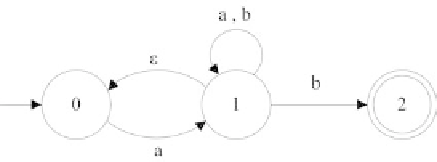Java Reference
In-Depth Information
Definition 2.4. A non-deterministic finite-state automaton (NFA) is a finite state automa-
ton that allows either of the following conditions.
More than one move from the same state, on the same input symbol, that is,
m(r;a) = s;
m(r;a) = t; for states r;s and t where s 6= t:
An -move dened on the empty string , that is,
m(r;) = s;
which says we can move from state r to state s without scanning any input symbols.
An example of a deterministic nite-state automaton is N = (;S;s
0
;M;F), where
= fa;bg;S = f0; 1; 2g;s
0
= 0;M = fm(0;a) = 1;m(0;b) = 1;m(1;a) = 1;m(1;b) =
1;m(1;) = 0;m(1;b) = 2g;F = f2g and is illustrated by the diagram in Figure 2.8. This
NFA recognizes all strings of a's and b's that begin with an a and end with a b. Like any
FSA, an NFA is said to recognize an input string if, starting in the start state, there exists
a set of moves based on the input that takes us into one of the final states.
But this automaton is definitely not deterministic. Being in state 1 and seeing b, we can
go either back into state 1 or into state 2. Moreover, the automaton has an -move.
FIGURE 2.8 An NFA.
Needless to say, a lexical analyzer based on a non-deterministic finite state automaton
requires backtracking, where one based on a deterministic finite-state automaton does not.
One might ask why we are at all interested in NFA. Our only interest in non-deterministic
finite-state automata is that they are an intermediate step from regular expressions to
deterministic finite-state automata.
2.6 Regular Expressions to NFA
Given any regular expression R, we can construct a non-deterministic finite state automaton
N that recognizes the same language; that is, L(N) = L(R). We show that this is true by
using what is called Thompson's construction:
1. If the regular expression r takes the form of an input symbol, a, then the NFA that
recognizes it has two states: a start state and a final state, and a move on symbol a
from the start state to the final state.









Search WWH ::

Custom Search